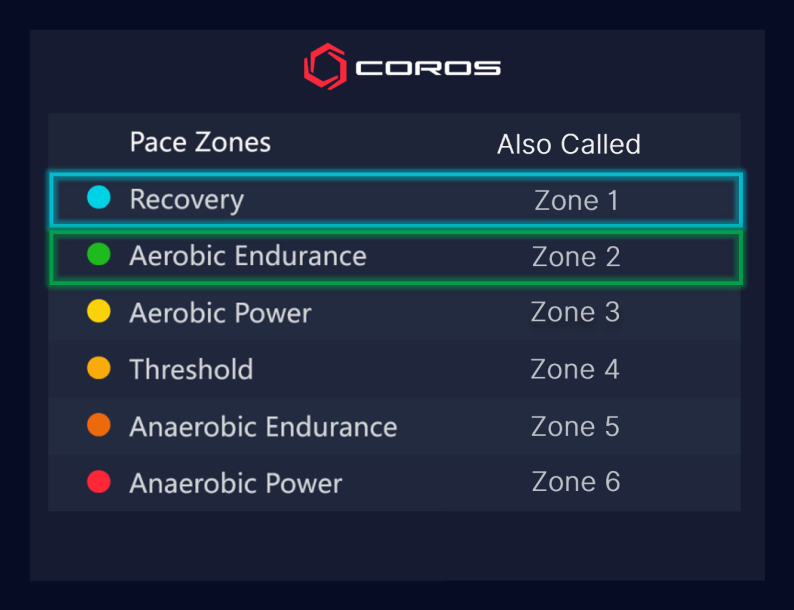Incorporating easy runs into your training regimen is essential for balancing intensity and promoting recovery. By focusing on Zone 2 heart rate, you can maximize the benefits of these runs, ensuring that your body recovers while building endurance.
Understanding the Heart Rate Zones
COROS uses a six-zone heart rate model to help athletes tailor their training intensity. Easy runs are designed to be run in the first two zones, known as Recovery and Aerobic Endurance. As a result, this article will focus primarily on those two zones.

COROS Education: Heart rate zones can be complicated if you're new to the topic. To learn more about how COROS uses heart rate zones, check out our article titled COROS Heart Rate Zones: The Ultimate Guide.
How Does Running in Zone 2 Help in Training?
Aerobic Endurance, also commonly known as Zone 2, is ideal for easy runs. This zone typically falls between 80-90% of your threshold heart rate. Running in this zone helps:
• Promote Recovery: Easy runs aid in muscle recovery by increasing blood flow without adding significant stress. Blood flow brings nutrients to areas of the body in need of recovery, and removes waste products from your working muscles.
• Build Aerobic Capacity: Consistently running in Zone 2 improves your body's ability to use oxygen, enhancing overall endurance. While higher zones also provide this benefit, athletes can spend more time in Zone 2 without reaching fatigue or needing extra recovery. This gives Aerobic Endurance running the best bang for your buck.
• Enhance Fat Metabolism: Training in this zone (along with Zone 1) encourages your body to use fat as a primary fuel source. Fat can produce more energy than other fuel sources, but the process takes a little longer. This trade-off may not be valuable to sprinters who need energy fast, but it is beneficial for long-distance runners who need energy over longer periods of time.
Integrating Easy Runs into Your Training Week
A well-rounded training plan includes a mix of easy runs, long runs, various hard workout sessions, and rest days. Here’s how to integrate easy runs effectively:
• Frequency: Nearly all runners will have 2 or more easy runs per week. The exact number varies depending on your skill level and total weekly volume.
- Beginners should run easy on nearly every session to avoid injury and build endurance. This could be 2-4 times per week, depending on how often you run.
- Intermediate runners will also have 2-4 easy runs each week, but may also complete 1 or 2 harder sessions like tempo or interval workouts.
- Advanced runners could run as many as six easy runs in a week, depending on where they are in the training cycle. Some advanced athletes will occasionally run two easy runs in one day, called "doubles".
• Duration: Easy runs typically last between 30-60 minutes. The duration can vary based on your overall mileage goals and fitness level. While many athletes will often do their long runs at the same pace, long runs have a different set of benefits and are typically categorized separately.
• Intensity: Easy runs should feel relaxed and enjoyable, allowing your body to recover while keeping you active. Maintain a steady pace where you can hold a conversation comfortably. This usually aligns with your Aerobic Endurance / Zone 2 heart rate, but may result in slightly higher heart rates in cases like hills, adverse weather, or illness.
Common Mistakes with Easy Runs
Many runners make mistakes with their easy runs that can hinder their training progress. The most common mistake is running too hard on easy days. Too often, runners aren't aware that it's okay for running to feel easy. You don't have to feel tired after every run. In fact, you shouldn't feel very tired after an easy run.

An example of a well-executed easy run
Above is an example of a well-executed easy run. The athlete spent most of their time in the Aerobic Endurance Zone (Zone 2), and spent the remaining time in the Recovery Zone (Zone 1). No time was spent in the higher-intensity zones.

An example of a poorly-executed easy run
In this next example, the athlete did not execute their easy run very well. Most of their run was spent in the Aerobic Power Zone (Zone 3), with some time at Threshold (Zone 4) and Anaerobic Endurance (Zone 5). Ultimately, 86% of the run was spent outside the recommended zones.
When athletes run above the target intensity like this, it can lead to a number of problems:
• Fatigue & Poor Workouts: When athletes run in higher-intensity zones (particularly Threshold and beyond), they need extra time to recover. If you run too hard on easy runs, you'll likely arrive at your hard workout days under-recovered and unable to perform at your best for the workouts. This is why runners should keep their easy days easy, and hard days hard.
• Injury & Burnout: When athletes don't get enough recovery, their performance can gradually decline. If this goes on for too long, your body will need to stop running. This will show either physically (injury) or mentally (burnout), but both will result in an extended break from running.
• Lack of Progress: When runners neglect Zones 1 & 2, they are unable to reap the benefits of easy running: recovery, aerobic endurance, and fat burning (as mentioned earlier). These are all critical for making progress as an endurance athlete, so remember to
Coaching Tip: While the Recovery and Aerobic Endurance zones set the foundation, a well-balanced training plan also includes time in the higher-intensity zones. Check out this article to learn more about the next zone: Aerobic Power.
Conclusion
Easy runs are a vital component of any training plan, providing the necessary balance between intensity and recovery. By staying in the Recovery and Aerobic Endurance zones, you can ensure these runs are truly easy and beneficial. Remember to integrate them thoughtfully into your weekly schedule and avoid common mistakes to get the most out of your training.
/fit-in/0x18/coros-v2/images/common/logo_black.png)





